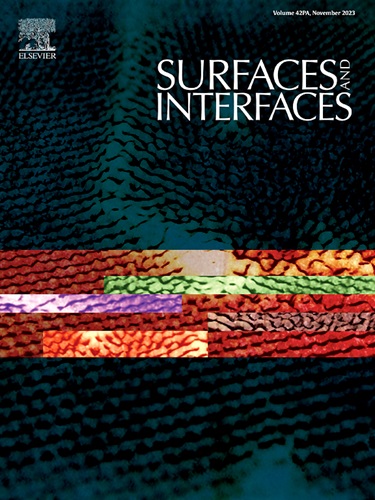Investigations on laser nitriding with trochoidal irradiation for enhancing corrosion resistance of laser-wire directed energy deposited low carbon steel
IF 5.7
2区 材料科学
Q2 CHEMISTRY, PHYSICAL
引用次数: 0
Abstract
This study presents the process improvement in high-temperature surface nitriding using a lower pulsed laser beam and a trochoidal laser irradiation strategy. The trochoidal irradiation strategy is implemented for nitriding process improvement on heterogeneous laser-wire directed energy deposited (LWDED) low-carbon steel in a nitrogen gas atmosphere. The trochoidal path improves nitriding by overcoming the beam overlapping effect and uniform heating during laser interaction. The process mechanism reveals the petal-like structure on the processed surface, which creates a large surface area. This large surface area helps the nitrogen atom trap during surface melting to form a nitride surface. The intermediate diffusivity from a pulsed laser enabled the controlled nitride growth. It facilitated localized diffusion and the precipitation of the uniform Fe-nitride layer. The EIS analysis showed that the sample nitride at a laser frequency of 100 Hz has the best corrosion resistance in a 3.5 % NaCl solution. The higher-order Fe-nitride formation at 100 Hz frequency is retained after the corrosion test. This finding highlights the superior stability and durability of the 100 Hz laser frequency nitriding compared to the other samples. The effect of pulse frequency and trochoidal path on the formation of Fe-nitride is thoroughly investigated before and after electrolytic corrosion test using advanced characterization techniques like scanning electron microscopy, Raman spectroscopy, X-ray photoelectron spectroscopy, X-ray diffraction and electrochemical analysis. This study demonstrates the effectiveness of pulsed laser nitriding and a trochoidal strategy for enhancing corrosion resistance in additively manufactured parts.
提高激光丝定向能沉积低碳钢耐蚀性的摆线激光渗氮研究
本文研究了采用低脉冲激光束和摆线激光照射策略对高温表面氮化的工艺改进。采用摆线辐照策略对非均相激光丝定向能沉积低碳钢在氮气气氛中渗氮工艺进行了改进。摆线路径克服了激光相互作用时的光束重叠效应和均匀加热,改善了氮化过程。加工机理揭示了加工表面的花瓣状结构,从而产生了较大的表面积。这个大的表面积有助于氮原子在表面熔化时形成氮化物表面。脉冲激光的中间扩散率使氮的生长受到控制。它有利于局部扩散和均匀氮化铁层的析出。EIS分析表明,在激光频率为100 Hz时,氮化物样品在3.5% NaCl溶液中的耐蚀性最好。在100hz频率下,高阶氮化铁的形成在腐蚀试验后仍然存在。与其他样品相比,这一发现突出了100 Hz激光频率氮化的优越稳定性和耐用性。利用扫描电子显微镜、拉曼光谱、x射线光电子能谱、x射线衍射和电化学分析等先进表征技术,深入研究了脉冲频率和曲线图路径对电解腐蚀试验前后氮化铁形成的影响。本研究证明了脉冲激光氮化的有效性和一种提高增材制造零件耐蚀性的摆线策略。
本文章由计算机程序翻译,如有差异,请以英文原文为准。
求助全文
约1分钟内获得全文
求助全文
来源期刊

Surfaces and Interfaces
Chemistry-General Chemistry
CiteScore
8.50
自引率
6.50%
发文量
753
审稿时长
35 days
期刊介绍:
The aim of the journal is to provide a respectful outlet for ''sound science'' papers in all research areas on surfaces and interfaces. We define sound science papers as papers that describe new and well-executed research, but that do not necessarily provide brand new insights or are merely a description of research results.
Surfaces and Interfaces publishes research papers in all fields of surface science which may not always find the right home on first submission to our Elsevier sister journals (Applied Surface, Surface and Coatings Technology, Thin Solid Films)
 求助内容:
求助内容: 应助结果提醒方式:
应助结果提醒方式:


